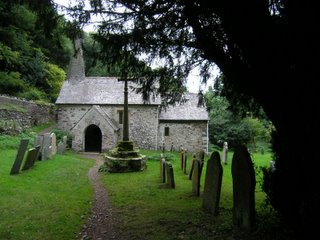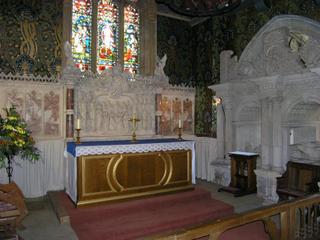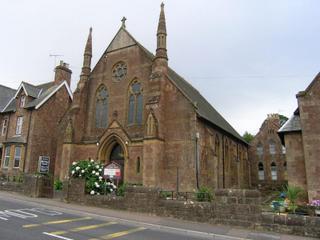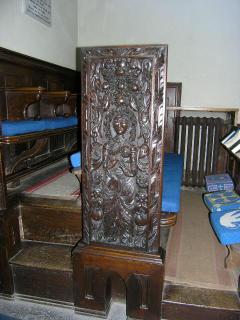Now where was I last time I wrote - ah yes - somewhere on the edge of Exmoor and it was still warm! Over the next few weeks I hope to play catch up, at a time of year that not many of us are out and about. That's all rather a rather feeble way of saying sorry the messages just stopped!
On the way back from Ilfracombe I decided to track down a very famous church, track down being the operative word. Forget Lullingstone and Upleatham, I was after England's smallest church without demolition of a nave....... and there it was a large pub on the A-road, The Culbone Inn, opposite a turning which I believed would get us towards the church. Off we sped down a road from the top of the moor towards the cliffs and the sea and yes we had an OS Map with us! This rather fine road finished at a co,plicated junction, a road straight on a road to the right and one then two roads to the left. The road to the left we needed got narrower and then dog-legged to the right with what was Culbone's vicarage on the road. A car park - looks good I thought - then a rather startled lady appeared who was staying at the vicarage-cum-holiday home who said that the church was accessed by a path further west again. We turned around and then drove on until the road itself seemed to stop at a farm. We turned around and discovered a small sign pointing down a track to Culbone Church, still a mile or so away. We parked badly because of other vehicles and in the end my friend decided to stay by the car and wait in case it had to be moved. Off I set, at a brisk pace, not wanting to keep my friend waiting any longer than necessary nor wanting to knock a chance to visit on the head either!
The track dropped gently down through another gate and turned left narrowed and increased in gradient. A couple o hundred yards later another choice - two signs Culbone Church 1 and Culbone church 0.5 (steep path). Yep I took the steep path entered the woods and it dropped -er- steeply down and was joined by a little stream. A house came into view, well it must have been a mill - and my path went around it, through a short tunnel under what may have been a road (where from?) and then there in front of me was England's Smallest Church.
 ST BEUNO, CULBONE, SOMERSET
ST BEUNO, CULBONE, SOMERSETis fabulous, architecturally nothing, set in a small grassed churchyard, with a large yew and seemingly surrounded by woodland. Beyond on a level with the west end was another house, usually hidden in photographs which suggest this church is in complete isolation. Nave, and proper chancel, south porch, no more than 35ft long (11m). Its slated spire is supposedly the top portion of the truncated shingled spire at nearby Porlock, transported here by the devil........... it's true! The face of the devil forms part of the Norman window on the north side of the chancel (externally). Inside equally charming, with medieval roof, pews and screen, and a later more grandiose (for Culbone that is) C17 or C18 family pew to the right hand side close to the screen. The font is half of one, built into the wall.
I could have stayed here ages - I had the place to myself but then there was my mate waiting by the car and the promise of a curry back in Williton. So I set back briskly the way I had come. Now here is the cautionary bit......... OK I am not the most fit guy, but neither am I someone who does not take exercise. I am a tad overweight, and have notched up a half century, but the thought of the return did not phase me. Things started well, but I was hurrying, but soon I could feel my heart beating, hear it beating, and my breath seemed to be difficult to get. Five times I rested, and to be honest, I think I started to panic. In the middle of nowhere, no phone, a friend waiting for me who did not know which way I had gone (who is less fit than me), and becoming increasingly worried as to whether I would make it back to the car. At the meeting of the two routes I threw myself to the ground and lay on this flatter bit of ground for a good five minutes until the thumping in my chest and the pounding in my head stopped and breathing became normal once more. I then set out to round the bend to have the car in sight at a much slower pace which remained fairly testing. As I rounded the bend my friend was there, he had a similar idea that things were not right and he had his phone with him - me of course just the camera!
Ha Ha HA! I laugh about it now, but this was the first time in my entire life that I had to face my own mortality! And as a nurse of course I qualify like most as a complete hyperchondriac. However in Williton I tell you that the pint of Cobra and the Curry tasted fabulous an hour later! Bugger the diet eh?
The next day (14th September) started off rather gloomy but got much better.
ST JOHN THE BAPTIST, CARHAMPTON, SOMERSET

The only place to pull in and park near the church is a pub's car park where unfriendly signs warn people off from so doing. Sod that. I even jumped over the car park wall into the graveyard to take this picture. This church is again of the C15 norm but the impressive tower is in fact of 1870, replacing a feebler effort with a weatherboarded upper stage. The church is in fact all rather over-restored inside, and apart from a pretty C18 pulpit has little to detain you long apart from the medieval rood screen. The colouring is a recent recreation of the original colour scheme from medieval times, in start contrast to the dark stained plain wood that is most today.
Next we did Dunster Castle, using my National Trust membership for the first time in years! Having done the town before we then left for places new, and headed for the complete grockle-haunt chocolate box village west of Minehead, also NT property with a HUGE brown tourist sign directing you off the A39.
This NT village is Selworthy but the church itself is worth the detour but it was not looking its best although it will soon.
ALL SAINTS, SELWORTHY, SOMERSET
was almost completely surrounded by scaffolding. The National Lottery that is English Heritage funding is being spent here in excess - odd that this church must be one of the most visited in
 the area and generates much more income from the sale of the tat that was on display (keyrings, mugs, pens, plaques, colouring books etc etc) in a month than others get over several years. That said it is a beautiful building with some splendid medieval roofs and carving. Dark windows does not let it be seen as it should so maybe a revisit will be necessary. Odd Sedan Chair-like opening from the parvise room into the south aisle, probably Georgian. The openings were closed too on this day but maybe are not usually so. There is also a west gallery and some interesting monuments.
the area and generates much more income from the sale of the tat that was on display (keyrings, mugs, pens, plaques, colouring books etc etc) in a month than others get over several years. That said it is a beautiful building with some splendid medieval roofs and carving. Dark windows does not let it be seen as it should so maybe a revisit will be necessary. Odd Sedan Chair-like opening from the parvise room into the south aisle, probably Georgian. The openings were closed too on this day but maybe are not usually so. There is also a west gallery and some interesting monuments.The National Trust Cottages are thatched and arranged around a green to the west of the church and easily missed if not on foot. I bet many tourists drive through without seeing these and question what was so special!
NB Like all other pictures on this blog these are enlargable by clicking on them.......



















